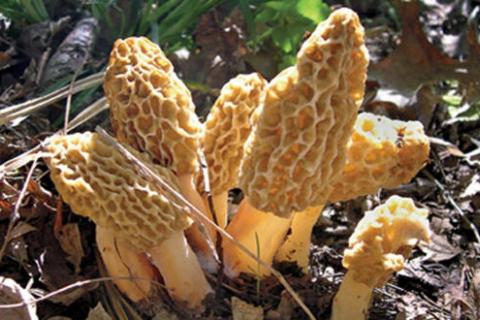
Interest in morel hunting has mushroomed in recent years. Competition for the succulent morsels is fierce. Only those who have honed their fungi hunting skills are able to routinely serve up mounds of this golden fried delicacy.

Possessing a sixth sense about the appearance of morels is a skill set that is acquired from many years of experience in the woods. “Most people these days (can’t) dedicate days at a time to hunting morels,” said naturalist Jim DiPardo.
Don’t worry, even if your sixth sense isn’t fully honed, there’s still hope for enjoying a meal of morels this spring. While DiPardo wasn’t willing to share the location of his favorite hunting spots, he did pass along six secrets that can help you track them down in your neck of the woods.
Tip: A Spring Trifecta: Recipes for Crappie, Morels and Wild Turkey
1. Calculate When the Morels Will Pop

“Morels begin to emerge when a combination of climactic factors converge,” DiPardo said. “Part of the mystery of hunting morels is figuring out when temperature, humidity, soil acidity and other factors are just right. A decreasing variance between daytime and nighttime temps is an important factor. When temperatures reach the forties at night and the sixties in the daytime, you better have your pickin’ bag ready. Paying close attention to these factors will greatly improve your success rate.”
2. Don't Wait for the Sun to Hunt Morels
A common misconception about morel hunting is that you must wait until the sun pops out after a spring rain. “Morels grow incredibly fast,” Dipardo noted. “If all conditions are right and it is going to rain until 3 p.m., be there before noon. You may beat someone else to the prize.”
3. Don't Trust Mother Nature
Just because you found morels in one spot last season, does not mean you will the next. The best plan is to have many locations where you have found morels over the years. Then you will have morels to eat every spring.
4. Check a Variety of Location Where Morels Can be Found
Morels may be found in many different locations. However, the best places are usually damp creek or river bottoms. Search around fallen timber that is decaying. Some suggest looking around trees that have just died. Many old timers also say that once a tree has lost its bark, morels will no longer grow around it. Don’t forget to check inside gooseberry and multi-flora rose brambles, too. You may be pleasantly surprised.
5. Use Your Binoculars to Help Find Morels
| Tip: "False morels," while sometimes can be consumed without ill effects, have been known to cause acute toxicity. The cap of the false morel appears wrinkled or "brainy," while real morels have honeycomb or net-like caps. An easier way to determine their difference: When the stem is cut open, false morels contain a cotton ball-type substance, while stems of the real kind are hollow. |
A pair of high quality binoculars will allow you to cover a lot of ground without wearing out your boots. Do some scouting from the road or take a glance across the creek before wading through. If you are glassing for spring turkeys don’t forget to take the occasional peek at the ground—morels and turkey breast can make a mighty fine meal!
6. Bring a Bag for the Mushrooms You Find
Be prepared. The opportunity to hunt morels may catch you off guard. Pack a bag in your vehicle, turkey vest, and tackle box. Small plastic bags are handy, but to ensure morels for the future, use a woven mesh bag—such as the ones oranges come in. Spores will fall from the morels you pick, seeding the area for the next season.
Links to Morel Recipes
2. How to Clean & Cook Morel Mushrooms
3. A Collection of Recipes Using Morels
- 63077 views

